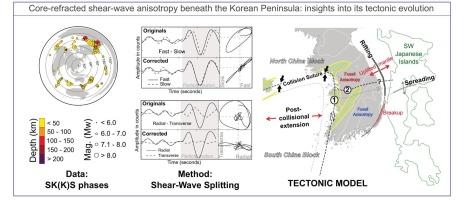Core-refracted shear-wave anisotropy beneath the Korean Peninsula: insights into its tectonic evolution
IF 7.2
1区 地球科学
Q1 GEOSCIENCES, MULTIDISCIPLINARY
引用次数: 0
Abstract
The tectonic history of the Korean Peninsula is marked by the Permo-Triassic collision between the North and South China blocks and the subsequently openings of the Yellow and East Seas during the Late Oligocene and Miocene. Despite well-constrained timing, the mechanisms behind these major tectonic episodes remain the subject of ongoing scientific debate. We studied seismic anisotropy from core-refracted shear-wave splitting to place constraints on lithospheric-scale and upper mantle structures and dynamics and provide insights into the tectonic evolution of the Korean Peninsula. We implemented the eigenvalue-based method to measure the splitting parameters and used the transverse energy minimization and cross-correlation techniques to validate our results. We found delay times ∼ 1.5 s which is consistent with anisotropy residing in the asthenospheric and/or lithospheric mantle. Our results strongly suggest that the anisotropy signature of past tectonic events have been preserved and that the upper asthenosphere and lithosphere have undergone coherent deformation. Based on our model, we interpret that the Hongseong-Imjingang belt is part of the collision boundary, since we observed a lateral variation of the splitting parameters coinciding with it. We suggest two possible scenarios for the continuation of the collision suture beyond this belt: (1) one offshore with the boundary coinciding with the West Marginal Fault Zone, and (2) another one onshore along the southern limit of the Gyeonggi massif. Our observations support a fan-shaped opening mechanism for the East Sea and an eastward post-collisional extension for the Yellow Sea. Lastly, the measured splitting parameters beneath the western Gyeonggi and Yeongnam Precambrian massifs appear to be in good agreement with a possible fossil anisotropy.

朝鲜半岛下核折射横波各向异性:构造演化的启示
朝鲜半岛的构造史以晚渐新世至中新世的二叠纪-三叠纪华北陆块与华南陆块的碰撞和随后的黄海和东海的张开为标志。尽管时间限制很严格,但这些主要构造事件背后的机制仍然是科学争论的主题。通过核折射剪切波分裂研究地震各向异性,对岩石圈尺度和上地幔结构与动力学进行约束,并对朝鲜半岛的构造演化提供见解。我们实现了基于特征值的方法来测量分裂参数,并使用横向能量最小化和互相关技术来验证我们的结果。我们发现延迟时间为~ 1.5 s,这与软流圈和/或岩石圈地幔的各向异性一致。我们的结果强烈表明,过去构造事件的各向异性特征被保留下来,上层软流圈和岩石圈经历了相干变形。根据我们的模型,我们解释洪城-临津江带是碰撞边界的一部分,因为我们观察到与之一致的分裂参数的横向变化。我们提出了两种可能的碰撞缝合线在该带之外继续存在的情况:(1)一种是在海上,其边界与西边缘断裂带重合;(2)另一种是在陆上,沿着京畿道地块的南部边界。我们的观察支持东海的扇形开放机制和黄海的碰撞后向东延伸。最后,测量的京畿西部和岭南前寒武纪地块下的分裂参数与可能的化石各向异性相吻合。
本文章由计算机程序翻译,如有差异,请以英文原文为准。
求助全文
约1分钟内获得全文
求助全文
来源期刊

Gondwana Research
地学-地球科学综合
CiteScore
12.90
自引率
6.60%
发文量
298
审稿时长
65 days
期刊介绍:
Gondwana Research (GR) is an International Journal aimed to promote high quality research publications on all topics related to solid Earth, particularly with reference to the origin and evolution of continents, continental assemblies and their resources. GR is an "all earth science" journal with no restrictions on geological time, terrane or theme and covers a wide spectrum of topics in geosciences such as geology, geomorphology, palaeontology, structure, petrology, geochemistry, stable isotopes, geochronology, economic geology, exploration geology, engineering geology, geophysics, and environmental geology among other themes, and provides an appropriate forum to integrate studies from different disciplines and different terrains. In addition to regular articles and thematic issues, the journal invites high profile state-of-the-art reviews on thrust area topics for its column, ''GR FOCUS''. Focus articles include short biographies and photographs of the authors. Short articles (within ten printed pages) for rapid publication reporting important discoveries or innovative models of global interest will be considered under the category ''GR LETTERS''.
 求助内容:
求助内容: 应助结果提醒方式:
应助结果提醒方式:


